Introduction:
I'm an Aerodynamicist. That's been my main focus since I began college. I like to work on projects that directly involve aerodynamics or rely on my knowledge of the subject. Computational Fluid Dynamics (CFD) is one of the tools in my quiver. I've been doing CFD for about 13 years, deriving and writing my own models from scratch. Most of the systems I've created have been targeted to model specific flows. Each was developed from first principles, building from either the Navier-Stokes or Euler equations. I've made systems modeling internal and external flows operating in the subsonic, transonic and supersonic regimes. I've employed finite-difference and finite-volume approaches to descretize the physical domains. Most of my work has modeled unsteady flows, using time-accurate, time-marching schemes, but I have also written a few systems that advance the solution in time using implicit schemes. I've also thrown in one or two space-marching solutions for good measure. I've modeled frozen, equilibrium and nonequilibrium flows. For some of my work, I've developed systems with non-reflective boundaries. And for some problems, I've written systems using "upwind" schemes to calculate the gradients or fluxes.
Some Examples:
One of the systems I've written computes the 2-dimensional, viscous
flow of air over a flat plate. The figure to the right shows a
contour plot of Mach number from a run using the simulation to
model the flow over a 5-degree wedge. The flow enters from the
left at Mach 4.
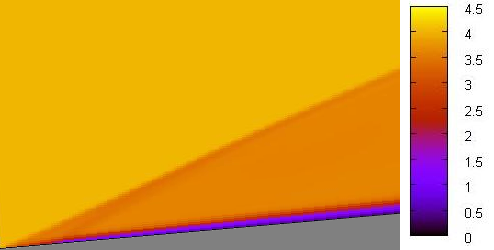 The strong shock wave that forms at the leading edge of the wedge
is clearly visible. It turns the flow 5 degrees so that it is
parallel with the upper surface of the wedge. There is an analytical
solution to this problem--oblique shock wave theory--which assumes
that the flow is inviscid. It predicts that the flow downstream of
the shock should be at Mach 3.64. The results here are very close
to that. Note how the viscous simulation captures the buildup of
the boundary layer and also the shock structures that form around
the leading edge of the wedge. (Click on any image on this page
to see a larger version.) The center figure in the masthead
of this page is the contour plot of pressure from the same simulation
run. The pressure rises sharply as the air flows through the shock
wave. The colors map just as they do in this figure, with yellow
indicating high pressure and blue low. Note the shock structures
around the leading edge of the wedge and the high pressures that form.
The strong shock wave that forms at the leading edge of the wedge
is clearly visible. It turns the flow 5 degrees so that it is
parallel with the upper surface of the wedge. There is an analytical
solution to this problem--oblique shock wave theory--which assumes
that the flow is inviscid. It predicts that the flow downstream of
the shock should be at Mach 3.64. The results here are very close
to that. Note how the viscous simulation captures the buildup of
the boundary layer and also the shock structures that form around
the leading edge of the wedge. (Click on any image on this page
to see a larger version.) The center figure in the masthead
of this page is the contour plot of pressure from the same simulation
run. The pressure rises sharply as the air flows through the shock
wave. The colors map just as they do in this figure, with yellow
indicating high pressure and blue low. Note the shock structures
around the leading edge of the wedge and the high pressures that form.
A very interesting application of the same simulation computes the
supersonic, viscous flow of air over a flat plate. This sounds like
a very simple flow scenario, but isn't. In fact, there is no
"closed-form" or analytical solution to the problem. The only
way to see what happens is to solve the problem numerically or
experimentally.
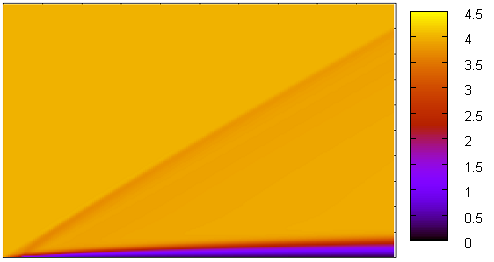 The figure to the left is a contour plot of Mach number. Air enters
from the left at Mach 4, and the flat plate forms the bottom edge of
the figure. The buildup of the boundary layer is clearly visible
above the flat plate. It causes a slight displacement of the main
flow. A weak shock wave forms to turn the flow slightly away from
the plate. What makes this problem interesting is that the boundary
layer is the reason the shock wave forms. If the flow were inviscid,
there would be no boundary layer and hence no shock wave at all.
The whole flowfield would be
at Mach 4, a pretty uninteresting solution. The CFD simulation is
accurate enough to resolve a collection of very weak shock waves,
commonly called "Mach waves", downstream of the first shock wave.
Each of these forms to turn the flow slightly more, accounting for
the ever-increasing growth of the boundary layer.
The figure to the left is a contour plot of Mach number. Air enters
from the left at Mach 4, and the flat plate forms the bottom edge of
the figure. The buildup of the boundary layer is clearly visible
above the flat plate. It causes a slight displacement of the main
flow. A weak shock wave forms to turn the flow slightly away from
the plate. What makes this problem interesting is that the boundary
layer is the reason the shock wave forms. If the flow were inviscid,
there would be no boundary layer and hence no shock wave at all.
The whole flowfield would be
at Mach 4, a pretty uninteresting solution. The CFD simulation is
accurate enough to resolve a collection of very weak shock waves,
commonly called "Mach waves", downstream of the first shock wave.
Each of these forms to turn the flow slightly more, accounting for
the ever-increasing growth of the boundary layer.

One of the greatest challenges that I've found in CFD is high
temperature gas flows. These are found in hypersonic flows, reentry
flows, combusting flows or other types of flows where the gas
is raised to high temperatures. The theory behind these flows combines
fluid mechanics with quantum mechanics. Now, that's
a challenge! These flows almost always
involve multiple species of gas in vibrational, chemical and electronic
nonequilibrium.
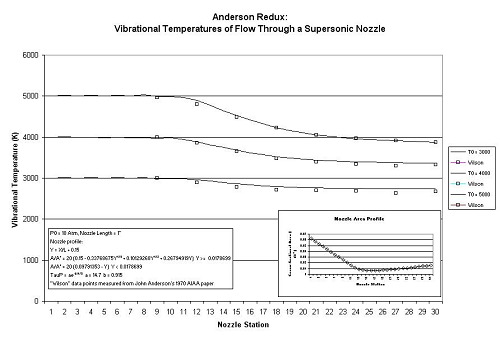 I needed to incorporate high-temperature flow models into my engine
simulation. Temperatures within the cylinder of a pistion engine
reach 4,000° F (2,200 C). And exhaust flow temperatures can
exceed 1,400° (760 C). Before incorporating these calculations
into the engine simulation, I needed to see if I understood all of
the high-temperature concepts and if I could apply them to a CFD
solution. While at the Naval Ordinance Laboratory, John Anderson
wrote a paper titled, "A Time-Dependent Analysis for Vibrational
and Chemical Nonequilibrium Nozzle Flows". In it, he generates and
presents data for a flow in vibrational nonequilibrium. I constructed
my own CFD simulation incorporating vibrational nonequilibrium so that
I could compare results. They are presented at the right. The figure
represents the "vibrational temperature", a measure of the vibrational
energy stored in diatomic nitrogen gas as it flows through a supersonic
nozzle. The gas is stored at high temperature and pressure in a
reservoir at the left side of the figure and then expands isentropically
through the nozzle, to the exit at the right. As you can
see from the plots, my system's predictions match the data from
Anderson's paper very well.
I needed to incorporate high-temperature flow models into my engine
simulation. Temperatures within the cylinder of a pistion engine
reach 4,000° F (2,200 C). And exhaust flow temperatures can
exceed 1,400° (760 C). Before incorporating these calculations
into the engine simulation, I needed to see if I understood all of
the high-temperature concepts and if I could apply them to a CFD
solution. While at the Naval Ordinance Laboratory, John Anderson
wrote a paper titled, "A Time-Dependent Analysis for Vibrational
and Chemical Nonequilibrium Nozzle Flows". In it, he generates and
presents data for a flow in vibrational nonequilibrium. I constructed
my own CFD simulation incorporating vibrational nonequilibrium so that
I could compare results. They are presented at the right. The figure
represents the "vibrational temperature", a measure of the vibrational
energy stored in diatomic nitrogen gas as it flows through a supersonic
nozzle. The gas is stored at high temperature and pressure in a
reservoir at the left side of the figure and then expands isentropically
through the nozzle, to the exit at the right. As you can
see from the plots, my system's predictions match the data from
Anderson's paper very well.

No CFD simulation can work without a grid or mesh generator. I've
written a number of them. The figure to the left shows a rectangular
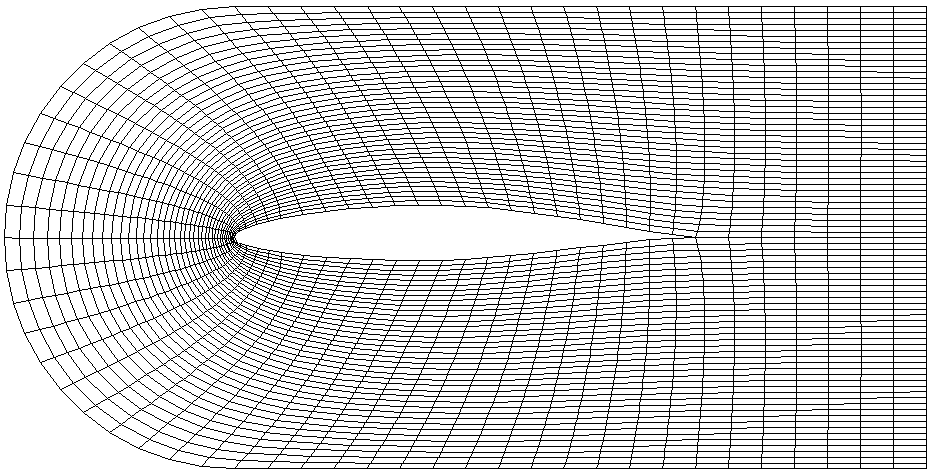 mesh wrapped around an NACA 65-212 airfoil. The spatial location of the cell
vertices at the airfoil surface and at the outer boundary is specified.
The interior vertices are then distributed in space elliptically using the
Laplace equation as a numerical artifice. The Laplace equation is
solved across the physical domain using a finite difference approach.
The system is mathematically elliptic in space and so I use a relaxation
technique to drive the system to the steady state, as you see it here.
mesh wrapped around an NACA 65-212 airfoil. The spatial location of the cell
vertices at the airfoil surface and at the outer boundary is specified.
The interior vertices are then distributed in space elliptically using the
Laplace equation as a numerical artifice. The Laplace equation is
solved across the physical domain using a finite difference approach.
The system is mathematically elliptic in space and so I use a relaxation
technique to drive the system to the steady state, as you see it here.
My engine simulation required a very special mesh generator. The
engine simulation allows the user to connect intake and exhaust pipes
together using a volume called a "collector". One requirement for
the development of the simulation was that it not require the use
of a CAD system when describing the layout of an intake or exhaust
system. When a user
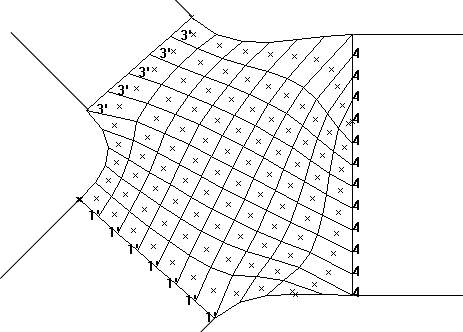 wants to connect pipes together, he only needs to state which pipes,
and which ends of those pipes, to connect together, and at
what angles those pipes must meet. The simulation automatically
generates a collector volume that will validly connect the pipes
together. Then it automatically lays out a rectangular computational
mesh inside of the volume. At the right, you see a collector that
connects three pipes together. One pipe connects horizontally, from
the right and two others connect at 45° and -45° angles from
the left. The numbers indicate the pipe that each collector boundary
cell connects to. The cells at the upper-left connect to pipe number
3. The primes on the numbers indicate that the cells connect to the
"nth" end of the pipe; un-primed numbers indicate that the cells
connect to the "0th" end. The shape of the collector wall between
pipes is generated using a cubic spline. The location of cell vertices
at the wall is laid-out uniformly. The spatial location of the interior
vertices is then generated elliptically, using the Laplace equation as
a numerical artifice. The "x" in each cell indicates the area centroid
of the cell.
wants to connect pipes together, he only needs to state which pipes,
and which ends of those pipes, to connect together, and at
what angles those pipes must meet. The simulation automatically
generates a collector volume that will validly connect the pipes
together. Then it automatically lays out a rectangular computational
mesh inside of the volume. At the right, you see a collector that
connects three pipes together. One pipe connects horizontally, from
the right and two others connect at 45° and -45° angles from
the left. The numbers indicate the pipe that each collector boundary
cell connects to. The cells at the upper-left connect to pipe number
3. The primes on the numbers indicate that the cells connect to the
"nth" end of the pipe; un-primed numbers indicate that the cells
connect to the "0th" end. The shape of the collector wall between
pipes is generated using a cubic spline. The location of cell vertices
at the wall is laid-out uniformly. The spatial location of the interior
vertices is then generated elliptically, using the Laplace equation as
a numerical artifice. The "x" in each cell indicates the area centroid
of the cell.
The figure at the left shows a collector in action, connecting
three pipes together. An exhaust header pipe, connected to
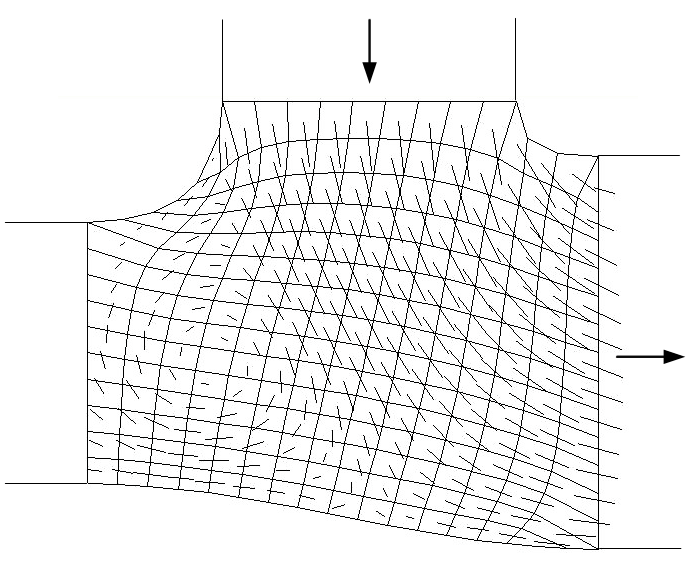 a cylinder at its far end, joins vertically. Another header pipe
connects horizontally from the left. A third exhaust pipe joins
at the right, its far end open to the atmosphere. The exhaust
valve at the far end of the left pipe is closed. The exhaust
valve connecting the top pipe to its cylinder is open, and the
piston is forcing the combustion charge out. The charge is flowing
down that pipe and through the collector. The flow enters the
collector and exits through the third pipe, toward the atmosphere.
The collector's computational mesh and the velocity vectors at each
cell are displayed. Because of the extreme computational constraints
facing an engine simulation, the flow through the collector is modeled
inviscidly. But note how the simulation is still able to resolve
an area of recirculating flow near the connection to the left pipe.
Also, note the stagnation point on the bottom wall. The flows within
an engine are entirely unsteady. What you see here is just a
snapshot in time.
a cylinder at its far end, joins vertically. Another header pipe
connects horizontally from the left. A third exhaust pipe joins
at the right, its far end open to the atmosphere. The exhaust
valve at the far end of the left pipe is closed. The exhaust
valve connecting the top pipe to its cylinder is open, and the
piston is forcing the combustion charge out. The charge is flowing
down that pipe and through the collector. The flow enters the
collector and exits through the third pipe, toward the atmosphere.
The collector's computational mesh and the velocity vectors at each
cell are displayed. Because of the extreme computational constraints
facing an engine simulation, the flow through the collector is modeled
inviscidly. But note how the simulation is still able to resolve
an area of recirculating flow near the connection to the left pipe.
Also, note the stagnation point on the bottom wall. The flows within
an engine are entirely unsteady. What you see here is just a
snapshot in time.
